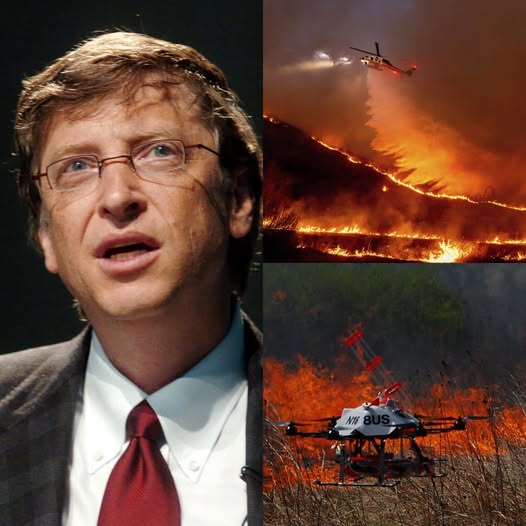In the wake of catastrophic wildfires, such as those that devastated Grand Canyon National Park, Bill Gates has made a significant commitment to invest a staggering $200 million in wildfire recovery and prevention. As wildfires increasingly become a destructive force due to climate change, Gates is taking decisive actions to tackle the environmental harm these fires inflict, especially in areas like the Grand Canyon.
His philanthropic commitment seeks to transform our approach to fire prevention, recovery, and ecosystem restoration. Gates’ emphasis is not solely on immediate recovery but also on the long-term resilience of the natural environment. By making substantial investments in wildfire prevention and rebuilding initiatives, Gates is contributing to a future where wildfires inflict less damage, and ecosystems can recover more swiftly.
The rising frequency and intensity of wildfires have emerged as one of the most urgent challenges in the fight against climate change. Over the past decade, wildfires have consumed millions of acres of land worldwide, leaving behind charred landscapes and devastated ecosystems.
The Grand Canyon wildfire stands as one of the most recent and destructive instances, resulting in not only widespread devastation but also a considerable challenge for environmental recovery. The fire obliterated critical infrastructure, including the Grand Canyon Lodge, and left a profound impact on the park’s ecosystems. The destruction of wildlife habitats, coupled with the threat of soil erosion and water contamination, presented a significant obstacle to restoration efforts.
Gates’ $200 million investment will support research and development in wildfire recovery, with the goal of creating fire-resistant infrastructures and ecosystems that are more capable of enduring the impacts of future fires. His commitment is centered on long-term solutions that not only address the immediate damage caused by wildfires but also enhance the resilience of ecosystems to withstand such occurrences in the future.
Wildfires have evolved from being merely a seasonal issue to a persistent threat throughout the year, particularly in areas susceptible to extreme heat, drought, and strong winds. Gates acknowledges the importance of immediate recovery actions, such as habitat restoration and the reconstruction of damaged infrastructure, but emphasizes that proactive measures are equally vital to mitigate the impact of future wildfires.
A significant aspect of Gates’ initiative involves investing in cutting-edge technologies and materials aimed at enhancing the fire resistance of communities and ecosystems. For instance, the use of wildfire-resistant building materials will be essential in the reconstruction of regions like Grand Canyon National Park. Gates has allocated funds to the large-scale development and implementation of these materials, ensuring that new constructions are capable of enduring the severe heat and flames associated with future wildfires.
These materials will serve not only to safeguard lives and property but also to lessen the financial repercussions of wildfires on local communities, which frequently suffer the most from such disasters. Gates’ emphasis on constructing climate-resilient infrastructure is a key component of his strategy to avert future fire damage and assist communities located in high-risk zones.
Beyond infrastructure enhancements, Gates is also financing extensive reforestation initiatives, which are vital for restoring ecosystems and alleviating the long-term consequences of wildfires. Wildfires typically devastate vast areas of vegetation, resulting in desolate landscapes that are prone to soil erosion and further environmental harm.
Replanting indigenous trees and plants is crucial for reinstating the natural equilibrium, preventing soil erosion, and supporting wildlife habitats. By investing in these initiatives, Gates is facilitating a quicker recovery for ecosystems, which is essential for preserving biodiversity and providing necessary resources for both humans and wildlife.
The emphasis on reforestation is especially significant in regions such as the Grand Canyon, where indigenous plants and trees are crucial for sustaining the ecological integrity of the park. Trees not only offer habitats for wildlife but also assist in regulating the local climate by absorbing carbon dioxide from the atmosphere. Reforesting the Grand Canyon and other areas affected by fire is vital for reinstating these environmental functions and ensuring that future generations can continue to appreciate the natural splendor of these iconic landscapes.
Gates’ $200 million pledge towards wildfire recovery also encompasses financing for innovative fire detection and prevention technologies. The creation of AI-driven systems capable of identifying wildfires in their initial stages is among the primary solutions being investigated. These systems can evaluate real-time data from satellite imagery and ground-based sensors to detect signs of fire before they escalate uncontrollably.
Timely detection is essential in reducing the damage inflicted by wildfires and enabling firefighters to respond swiftly. Gates is additionally supporting research into fire suppression technologies, which includes the advancement of more efficient firefighting techniques and tools suitable for use in remote and difficult terrains.
As a philanthropist, Gates has been a vocal proponent of leveraging technology to tackle global issues, and his investment in wildfire prevention is no exception. He has consistently backed research in sustainable energy and climate change solutions, acknowledging that technology is instrumental in mitigating the effects of environmental disasters.
By investing in state-of-the-art fire prevention and recovery technologies, Gates is contributing to the establishment of a future where wildfires are less devastating and more controllable, even amidst a changing climate.
Bill Gates’ $200 million investment in wildfire recovery and prevention arrives at a moment when the world is confronting an unparalleled climate crisis. Wildfires, which were once infrequent and isolated occurrences, have now evolved into a global issue, resulting in catastrophic effects on communities and ecosystems. Gates has leveraged his substantial wealth and influence to allocate resources aimed at addressing the climate crisis, and his dedication to wildfire recovery exemplifies his approach to tackling the immediate repercussions of climate change.
Through his philanthropic efforts, Gates is striving to ensure that communities and ecosystems are better equipped to face the challenges that lie ahead, offering a model for others to emulate in the battle against climate change.
The long-term consequences of wildfires reach far beyond the immediate destruction they inflict. Besides obliterating infrastructure and habitats, wildfires also contribute to air pollution and greenhouse gas emissions, which further intensify the climate crisis. Gates’ initiatives to avert wildfires and rehabilitate affected ecosystems are integral to a comprehensive strategy aimed at combating climate change and fostering sustainability.
His investment in wildfire recovery transcends environmental concerns; it also poses a public health issue, as wildfires emit toxic smoke and particulate matter that can adversely affect human health. By financing research and development in fire prevention and recovery, Gates is addressing these health hazards and safeguarding vulnerable communities.
As the world continues to contend with the ramifications of climate change, Bill Gates’ $200 million investment in wildfire recovery and prevention stands as a testament to the urgent need for immediate action to safeguard the environment and support communities. His philanthropic endeavors are contributing to the creation of a future where wildfires are less devastating, and ecosystems exhibit greater resilience.
Gates’ initiatives will be pivotal in safeguarding the natural environments we value for the benefit of future generations, while also ensuring that the communities impacted by these calamities are prepared to recover and prosper. By dedicating himself to climate resilience and environmental rehabilitation, Gates demonstrates that transformation is achievable, and that with appropriate resources and technologies, we can alleviate the impacts of climate change and create a sustainable future for everyone.






